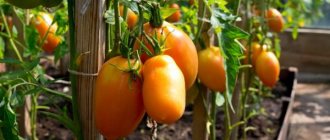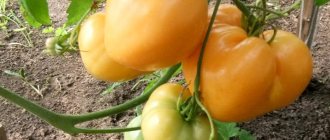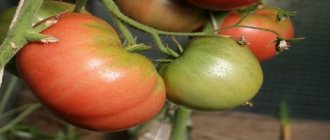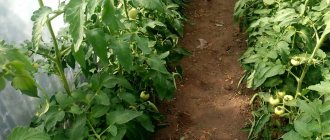Characteristics and description of the variety
A mid-early tomato variety, Orange Elephant, is a product of selective seed production. It was included in the State Register of Russia in 2011. The culture was created for cultivation in film-type greenhouses in all regions of the country. Suitable for cultivation in the south in unprotected soil.
The bushes are determinate: in closed ground they reach 1 m, in open ground - 70 cm. The plant does not need frequent pinching. As they grow, young shoots are removed and a bush of 1-2 stems is formed. Stems with heavy fruits are tied to stakes or trellises.
The photo shows Orange elephant tomatoes.
The table summarizes cultural features:
| Options | Characteristics |
| Ripening time | 100–110 days after germination. |
| Leaves | Medium size, light green. |
| Fruit shape | Rounded. |
| Weight | 130–160 g. |
| Type of inflorescences | Simple. |
| Number of slots | 3-4. |
| peduncle | With articulation. |
| Skin | Smooth thin. |
| Coloring | Orange. |
| Pulp | Medium density. |
| Taste | Sweet pleasant. |
| Harvest from 1 m² | 5-6 kg. |
| Transportability | High. |
Tomato Orange Elephant: reviews, photos
Growers who are also breeders find it interesting to work with mass-produced tomatoes, since they often have similar genetic roots, but may differ in a number of traits that are interesting to different gardeners.
On the other hand, the passion of many people for collecting makes them, having purchased one tomato from a whole series, want to try all the others. Moreover, if the experience of growing the first variety was successful. And this is more than justified in relation to the group of tomatoes, united by the fact that the word “elephant” appears in the name of the variety. All tomato “elephants” are quite unpretentious in care, but they differ in the variety of colors, tastes and sizes of the fruits and plants themselves.
In this article we will talk about a tomato called Orange Elephant, which, according to its characteristics, is the smallest representative of this tomato family. Other "elephants", such as the Pink Elephant or the Crimson Elephant, are more suited to their name due to the size of their fruits and bushes.
The Orange Elephant tomato, like most of its brethren from this series of tomatoes, was obtained by agro breeders. It is sold in bags of the “Russian Hero” series. In 2011, this tomato was included in the State Register of Breeding Achievements of Russia. It was recommended for cultivation in all regions of Russia in film or polycarbonate greenhouses.
Attention! This variety of tomatoes was specially bred for growing in greenhouses.
Of course, in the southern regions of Russia you can try growing it in open ground. This condition is due, first of all, to the fact that this tomato has a fairly early ripening period. Tomatoes ripen approximately 100-110 days after the emergence of full shoots. Therefore, in order to get a really early tomato harvest, it is advisable to plant the seedlings in the ground as early as possible, no later than May.
For southern regions with warm and sometimes hot spring, this is quite acceptable. But in the middle zone and Siberia in May, tomato seedlings can only be planted in greenhouses, or at least under film covers. But when planted in a greenhouse, the first ripe fruits can be obtained already at the end of June - in July.
The Orange Elephant tomato belongs to the determinant type, which means it is limited in growth. And, indeed, its height in open ground does not exceed 60-70 cm. When cultivated in a greenhouse, the bush can reach a height of 100 cm. Although, according to reviews from gardeners in some areas with warm climates, the Orange Elephant tomato has reached a height of 1.6 meters.
Since the Orange Elephant tomato is determinate, it does not need pinching. But a garter to the stakes will never be superfluous, since without it, bushes with ripening tomatoes can simply collapse to the ground. The leaves on the bushes are medium in size, dark green, and have a traditional tomato shape.
The description of the variety will be incomplete without such characteristics as productivity, but here the Orange Elephant was not up to par. On average, you can get from two to three kilograms of tomatoes from one bush. And from one square meter of planting you can thus get up to 7-8 kg of fruit.
Advice! If you're looking for yield, try planting Pink or Crimson Elephant. Their yields are 1.5-2 times higher.
The variety is quite resistant to adverse weather conditions, and tolerates heat especially well, including abnormal heat. It sets fruit quite well in these conditions, so it is suitable for growing by gardeners from the southern regions. The fruits are not subject to cracking. As for disease resistance, it is at an average level, on par with most tomato varieties.
Tomatoes of the Orange Elephant variety have the following characteristics:
- The shape of the fruit is traditionally round, but slightly flattened both above and below. There is ribbing at the base of the stalk.
- At the stage of technical maturity, the fruits are green; when ripe, they become bright orange.
- The skin is quite dense, smooth, the surface of the tomato is elastic.
- The pulp is tender, juicy, and its color is soft orange. Tomatoes contain a large amount of beta-carotene, which prevents the aging process and also has a beneficial effect on vision, immunity and regenerative processes on the skin.
- Manufacturers claim that the average weight of tomatoes is 200-250 grams. Perhaps such fruits can be achieved if the number of fruits in the clusters is normalized. According to gardeners, the average weight of tomatoes is only 130-170 grams.
- The taste of the tomatoes is rated as excellent. The fruits have a rich, sweet taste and pleasant aroma.
- The number of seed nests is average - from three to four.
- The fruits are best used for preparing salads and original-colored tomato juice. They are not very suitable for canning for the winter, except for making sauces, squash caviar and similar dishes.
- Of the entire family of elephants, it is the Orange elephant that is best stored and withstands transportation.
- It ripens well in room conditions without losing its taste.
- The fruiting period is long - tomatoes can set fruit and ripen for several months.
Like most vegetables, the Orange Elephant variety has advantages that are appreciated by gardeners who choose this tomato for growing:
- Fruiting over a long period.
- Good preservation of fruits and transportability, unlike other tomato “elephants”.
- Original color and excellent taste of the fruit.
- Increased usefulness of tomatoes due to the content of various additional elements and vitamins.
- Disease resistance.
- Easy to grow.
Among the relative disadvantages are:
- Not the largest fruit size compared to other tomato “elephants”.
- Not as high a yield as other comrades in the series.
Since the Orange Elephant tomato is recommended to be grown in greenhouses in most regions, seeds can be sown for seedlings starting in March. If there is a desire to experiment, gardeners in the southern regions can try sowing this tomato in April in the soil of an unheated greenhouse, in order to later transplant it into open ground or leave it to grow under a roof all summer.
Comment! The Orange Elephant variety is unpretentious, therefore, the main thing it needs during the seedling period is an abundance of light and moderate watering with the same moderate (not hot) temperature regime.
In such conditions, the seedlings will grow the maximum number of roots and will be able to quickly grow after planting.
When sowing seeds in fertile soil, fertilizing is not required before planting tomatoes in a permanent place. It is necessary to plant seedlings while maintaining a sufficient distance between plants (at least 30-40 cm), even if at first it seems that they are planted too far from each other.
It is very advisable to immediately tie the Orange Elephant seedlings to stakes upon planting and mulch them with straw or rotted sawdust. If everything is done correctly, further care will be reduced to watering once a week, fertilizing twice a month and harvesting.
Reviews from gardeners about the Orange Elephant tomato are mixed, but generally positive.
Dmitry, 39 years old, Abinsk I bought a bag of Orange Elephant tomato seeds several years ago, but somehow I kept putting off planting it. This year I finally planted it as seedlings along with 5-6 varieties of other tomatoes. I planted everyone in open ground. And the Orange Elephant turned out to be the best. In the summer it was catastrophically hot here, and he was the only one of the tomatoes that tolerated these conditions well and did not get baked. On many other bushes the fruits came across with rot, but in this same variety the tomatoes were smooth, beautiful, without a single spot. At the same time quite large in size. I will definitely plant it now. Irina, 35 years old, Balabanovo Planted an Orange Elephant tomato in a greenhouse. It seems to me that the yield was very good. I even counted - 4 clusters of 4 fruits each ripened on one bush. Each fruit weighed about 200 grams, so do the math for yourself. The taste is good - sweet, juicy with a slight sourness. Suitable for salads and canning if cut into pieces. Natalia, 42 years old, Orenburg We grew this tomato variety last year, and we also plan to plant several bushes this year. We sown it in mid-March, the seeds sprouted well, and the seedlings were quite strong. They were planted in the ground under temporary shelters at the end of May. The tomatoes turned out to be large in size, beautiful in color, and even. Meaty, but juicy and tender at the same time. They are not suitable for pickling in jars, but they are very good as an additive to other vegetable preparations when you need to make tomato paste or puree. They are also good in salads, especially when mixed with tomatoes of other colors. Olga, 32 years old, Kostroma Planted Orange Elephant in open ground, the bushes grew no more than 70 cm. The variety is determinate, ripened closer to August. The fruits are quite even, neat, dense, the taste is good and sweet. The yield, however, was average.
Among tomatoes with exotic fruit colors, Orange Elephant stands out primarily for its unpretentiousness. Therefore, novice gardeners who are afraid to take on exotic varieties of tomatoes due to their inexperience can be advised to start with this variety.
Growing seedlings
Preparation of seeds for seedlings begins 50–65 days before transferring to the ground:
- in the northern regions - in early April;
- in the regions of the middle zone - in mid-March;
- in the south - in early March.
Seed preparation
Experienced farmers advise updating planting material annually and not using seeds from previously grown tomatoes. Before sowing, preliminary disinfection of grains is carried out in a pink solution of potassium permanganate (30 minutes) or in a 2% peroxide solution (10 minutes).
To stimulate germination, seeds are soaked in special preparations. The most popular are “Epin”, “Zircon”, “Immunocytophyte”, “Baikal”.
The soil
The soil for tomato seedlings should be light and nutritious. A mixture of turf soil, peat and river sand in equal parts is suitable. As fertilizers, 40 g of superphosphate and 15 g of potassium are added to 10 liters of water.
Instead of soil made with your own hands, use a ready-made balanced substrate for tomatoes.
Both mixtures need to be sanitized in the oven or microwave. In practice, a quick and effective disinfection method is often used - watering with a strong solution of potassium permanganate.
Sowing
Containers for seedlings no more than 7 cm high are filled with a moist substrate and seeds are placed in it to a depth of 1.5 cm with an interval of 2 cm. Sprinkle the top with a layer of earth (1 cm) and cover with glass or plastic film. The future seedlings are taken to a dark place. Shoots appear at a temperature of +23 °C in 4–6 days.
Seedling care
After the first leaves appear, the film or glass is removed and the containers are placed on the windowsill on the south side. Seedlings like moderate watering no more than once a week.
Seedlings are fed once every 15 days with ready-made fertilizers according to the instructions on the package: Agricola, BioMaster, Biohumus. The complexes contain a large amount of nitrogen necessary for rapid crop growth and green mass gain. It is important not to overdo it here, otherwise the root system will “burn out.”
Advice . After watering, “dust” the soil with wood ash for additional nutrition of the greenery.
With the appearance of 2-3 true leaves, the seedlings are planted in individual plastic or peat containers.
A week before moving to a permanent place, the plants are taken out into fresh air for hardening. Starting with 1 hour of being outside, the time is gradually increased to the whole daylight hours.
Planting seeds for seedlings
This tomato variety gives a richer harvest if grown in open ground. In greenhouse conditions, good performance can also be achieved, but for this the crop will need more careful care. In greenhouses, fewer fruits always ripen.
Seed preparation
Before you start sowing the seeds of the Orange Elephant variety for seedlings, they need to be prepared. To select suitable specimens, you will need to place them in salt water heated to 60 °. Those that end up on the surface are immediately removed.
The remaining ones are soaked in a weak solution of potassium permanganate to disinfect them from infections and then sown. The main thing is to dry them before immersing them in the ground.
Landing technology
The time for sowing Orange Elephant tomato seeds for seedlings is mid-March - early April. The characteristics of this process will make it elementary if the necessary conditions are met:
- First prepare the containers. They can be treated with a weak solution of potassium permanganate to prevent the development of diseases;
- Then the earth is poured into them. It is better to choose garden soil mixed with a small amount of humus. To make it looser and lighter, use river sand;
- Make small depressions on the surface of the ground where the seeds will be placed. The distance between two adjacent recesses should not exceed 2 cm;
- after the seeds have been placed in the soil, another layer of earth 5-6 mm thick is added on top. Otherwise, the seeds will take a long time to germinate and it is not a fact that all of them will sprout;
- Next, water the seedlings, but be careful so that the water does not deepen the seeds too much.
If it is necessary to accelerate seed growth, use special films. They cover the seedling containers from the very moment of sowing. It will need to be removed periodically to ventilate the soil. As soon as the first shoots begin to appear, the film can be removed.
():
To get friendly and quick shoots, keep containers with seeds at a temperature of 25-28 degrees. This is the optimal temperature for tomato seed germination.
Principles of agricultural technology
Orange elephant tomatoes are easy to care for. For active fruiting during cultivation in the garden and greenhouse, it is enough to adhere to the correct regime of watering, fertilizing, loosening the soil or mulching.
Landing
50–65 days after emergence, the strengthened seedlings are transferred:
- to the garden - in the last ten days of May or the first ten days of June;
- to the greenhouse - in the 1-2 decades of May.
Young plants must have a strong stem and strong rhizome, one flower ovary, and a height of at least 30 cm.
Planting pattern - 40x60 cm, no more than 2-3 bushes per 1 m².
For planting, choose a cloudy, windless day or wait until the evening. The seedlings are moistened abundantly, and the lower and yellow leaves are torn off.
The soil is loosened and fertilized with compost or humus mixed with ash (1 bucket per 1 m²). The holes are dug at a depth of 20 cm and filled with boiling water or a concentrated solution of potassium permanganate.
The seedlings are carefully moved along with the earthen ball, the soil is compacted and covered with mulch. The bushes are immediately tied to wooden stakes in the garden or trellises in the greenhouse.
Care
Fruiting of the Orange Elephant depends on proper watering. Plants are watered infrequently, but abundantly, until the soil is completely dry.
Water is poured strictly under the roots, and the above-ground part is irrigated with a spray bottle in the evening. This reduces the risk of fungal infection. At the initial stage of growth, about 5 liters of water per 1 m² are used. Flowering and fruiting bushes require at least 10 liters per 1 m².
Despite their short stature, tomatoes need to form bushes with 2 stems. To do this, young shoots are removed, leaving only one stepson growing from the leaf axil at the very bottom. This allows you to achieve higher yields.
Mulching the soil with sawdust, pine needles, agrofibre, hay, and straw eliminates routine loosening and weeding after each watering.
After transferring the seedlings to a permanent place, fertilizers are applied every 14-15 days:
- infusion of chicken manure in a ratio of 1:20 - 2 weeks after planting;
- nitrophoska solution (60 g of substance per 10 liters of water) - for subsequent fertilizing.
Plants respond well to ready-made fertilizers: “Red Giant”, “Biohumus”, “Agricola”, “Effecton-O”.
Diseases and pests
The Orange Elephant variety cannot boast of strong immunity: plants are often attacked by a fungus if not properly cared for. At the genetic level, the crop is protected from verticillium and fusarium.
Late blight, powdery mildew, and cladosporiosis are especially dangerous for tomatoes.
Signs of late blight:
- brown-gray spots on leaves and stems;
- whitish coating on the back of the leaves;
- spots on fruits and their deformation.
Signs of powdery mildew:
- white-yellow coating on leaves and stems;
- small brown dots (spores);
- drops of dew on greenery;
- leaves curled up.
Signs of cladosporiosis, or brown spot:
- yellow spots on leaves;
- brown coating on their underside.
For prevention, bushes are treated with fungicides (Ridomil Gold, Oxychom, HOM) before flowering and ovary formation, once every 20 days.
The drugs Fitosporin, Fitoflavin, and Bravo are safe and effective in the fight against fungi. Bushes are treated once every 2 weeks.
Preventive measures are no less effective:
- disinfection of greenhouses with sulfur bombs;
- soil treatment with copper sulfate;
- removing the lower leaves of plants;
- timely feeding with phosphorus and potassium;
- soil mulching;
- normalization of humidity in the room through ventilation.
“Fitoverm”, “Flumite”, “Grom”, “Strela”, “Konfidor”, “Aktara”, “Borneo” will help fight aphids, whiteflies, spider mites, and Colorado potato beetles.
Pest and disease control
Orange elephant tomatoes have a strong immunity to fungal diseases, but if not properly cared for, the plant can be affected by the following diseases:
- Powdery mildew - affects the stems and leaf blades, covering them with a white, airy coating. The disease often appears at low air humidity.
- Brown spot - appears on the leaves in the form of yellow-green spots. Without treatment, the leaf turns brown, dries out and falls off.
- Tomato mosaic is a viral disease that appears at elevated air temperatures. The disease appears on leaves, stems and fruits.
- Anthracnose - a disease that affects leaves and mature tomatoes, forming dark-colored spots on them that begin to grow over time.
- Late blight is a common disease of tomatoes. The disease affects fruits and leaves. Vague spots of black, brown or gray appear on them. To get rid of the disease, the bush is treated with fungicides.
The nuances of growing in open and closed ground
The crop grows and bears fruit better in soil with neutral acidity (pH=7). To determine the indicator, litmus strips or a special device with a probe are used. Wood ash will help balance acidity:
- at higher values, add 400–500 g per 1 m²;
- for medium - 200–300 g 1 m²;
- at low temperatures - 200 g per 1 m².
To maintain the optimal level of humidity after spraying the bushes, the windows and doors in the greenhouse are kept open.
Tomatoes ripen faster at a room temperature of +18...+25 °C during the day, and +15...+18 °C at night.
How to care
Tomatoes need constant care. If you do not provide them with the necessary conditions for growth, the fruits will not ripen to the required size, and the taste will not be as sweet as it should be. Care is not that difficult.
The greenhouse must be ventilated daily by opening the window and door. This way the plants will receive the necessary air, and excess moisture will leave. Water these tomatoes twice a week. There should be enough water, but it is not recommended to fill them, otherwise rotting will begin. Watering is carried out at the root. The leaves can be lightly sprayed with clean water; the water should not be icy, preferably settled. It can be poured into a barrel in advance.
You need to be very careful to ensure that the soil is good, fertilized, and not acidic. You can purchase a special device for measuring acidity. Top dressing can be at the root or foliar. As fertilizers, these varieties prefer manure, humus, chicken droppings, ammonium nitrate, potassium sulfate, nitrogen, and minerals. The best time to feed is early morning or evening.
All weeds must be removed by the roots, otherwise the fruits may grow tasteless and small, because the weed takes away all the juices from the crops. In addition, it can transmit pests. At the same time, loosen the soil twice a month so that it is soft and light.
Pest control and preventive measures are the most important part of caring for hybrids. You can spray the foliage with soap solution, potassium permanganate, infused herbs or garlic solution. Among the harmful insects, beetles, mites, butterflies, slugs, and caterpillars most often attack.
If tomatoes become stained or develop fungal infections, it is best to remove spoiled leaves and fruits and purchase remedies for these diseases at the store. But the elephant rarely gets sick; it has a strong immune system. He can begin to suffer only if he is not properly cared for. Therefore, it is necessary to carefully monitor the quality of watering, the level of humidity and feed on time.
Harvesting and application
The fruiting period of the Orange Elephant is extended, which allows you to enjoy the excellent taste of the fruit longer. To increase productivity, tomatoes are harvested at the stage of milky ripeness and left to ripen in boxes.
The fruits are used to prepare seasonal vegetable salads and snacks. They produce delicious tomato juice with an original color. Fully ripe tomatoes are suitable for adjika, sauces, and vegetable caviar. Small fruits are suitable for canning entirely.
Advantages and disadvantages of the variety
Advantages of culture:
- sweet pleasant taste of fruits;
- juicy fleshy pulp;
- ease of care;
- possibility of growing in open and closed ground;
- long fruiting;
- excellent transportability;
- a large amount of vitamins A, C, beta-carotene in the pulp;
- possibility of ripening outside the bush.
Flaws:
- low yield compared to other varieties of the variety;
- the need for pinching and gartering;
- predisposition to fungal diseases.
Other varieties of the variety
In addition to the Orange Elephant, there are several types of this tomato variety.
Yellow elephant
An early ripening variety for greenhouse cultivation.
| Options | Characteristics |
| Ripening time after germination | 100–105 days. |
| Leaves | Medium size, green. |
| Fruit shape | Flat-round, medium ribbed. |
| Weight | 300–350 g. |
| Type of inflorescences | Intermediate. |
| peduncle | With articulation. |
| Skin | Dense. |
| Coloring | Yellow. |
| Pulp | Medium density. |
| Taste | Sweet pleasant. |
| Harvest from 1 m² | 16-17 kg. |
Red elephant
An early ripening variety for film greenhouses.
| Options | Characteristics |
| Ripening time after germination | 100–105 days. |
| Leaves | Medium size, green. |
| Fruit shape | Flat-round, medium ribbed. |
| Weight | 300–350 g. |
| Type of inflorescences | Simple. |
| peduncle | With articulation. |
| Skin | Dense, but not rigid. |
| Coloring | Red. |
| Pulp | Fleshy and sugary. |
| Taste | Sweet pleasant. |
| Harvest from 1 m² | 12-13 kg. |
Raspberry elephant
An early ripening variety for indoor soil.
| Options | Characteristics |
| Ripening time after germination | 110–115 days. |
| Leaves | Medium size, green. |
| Fruit shape | Round, slightly ribbed. |
| Weight | 300–600 g. |
| Type of inflorescences | Simple. |
| peduncle | With articulation. |
| Skin | Thin and easy to separate. |
| Coloring | Pink. |
| Pulp | Medium density. |
| Taste | Sweet. |
| Harvest from 1 m² | 6–8 kg. |
Pink Elephant
Mid-season variety for indoor soil.
| Options | Characteristics |
| Ripening time after germination | 112–115 days. |
| Leaves | Potato type, medium size, green. |
| Fruit shape | Flat-round, strongly ribbed, apex with a notch. |
| Weight | 250–300 g. |
| Type of inflorescences | Intermediate. |
| peduncle | With articulation. |
| Skin | Dense, but not rigid. |
| Coloring | Pink with a green spot. |
| Pulp | Meaty. |
| Taste | Sweet without sourness. |
| Harvest from 1 m² | 6–8 kg. |
Black elephant
Mid-season variety for protected and unprotected soil.
| Options | Characteristics |
| Ripening time after germination | 110–115 days. |
| Leaves | Large green. |
| Fruit shape | Flat-round, strongly ribbed. |
| Weight | 190–350 g. |
| Type of inflorescences | Intermediate. |
| peduncle | With articulation. |
| Skin | Thin. |
| Coloring | Black-brown with a green spot near the stalk. |
| Pulp | Meaty. |
| Taste | Sweet with sourness. |
| Harvest from 1 m² | 7–9 kg |
Sugar elephant
The variety was bred by Russian breeders in 1989 for greenhouses in the northern regions and open ground in the south.
| Options | Characteristics |
| Ripening time after germination | 110–115 days. |
| Leaves | Large green. |
| Fruit shape | Flat-round. |
| Weight | 300–600 g. |
| Type of inflorescences | Intermediate. |
| peduncle | With articulation. |
| Skin | Thin smooth. |
| Coloring | Pink. |
| Pulp | Meaty. |
| Taste | Sweet. |
| Harvest from 1 m² | 4–6 kg. |
Farmer reviews
Those who tried to grow the Orange Elephant variety on their plots were satisfied with the harvest and taste of the fruit:
Olga, Olkhovatka village, Voronezh region: “I planted the variety in the garden last year. Before this, I read reviews from summer residents. It was hot outside, but the plants withstood the drought. From each bush I collected about 5 kg of selected tomatoes. The color turned out not bright orange, as in the picture, but yellow. The taste is excellent, sweet without sourness.”
Victor, Krasnaya Yaruga village, Belgorod region: “I prefer to plant Orange Elephant tomatoes in a film greenhouse. I grow them for myself; everyone at home likes their rich taste and bright color. We eat only fresh. The yield is low, but it bears fruit steadily until the end of August.”











